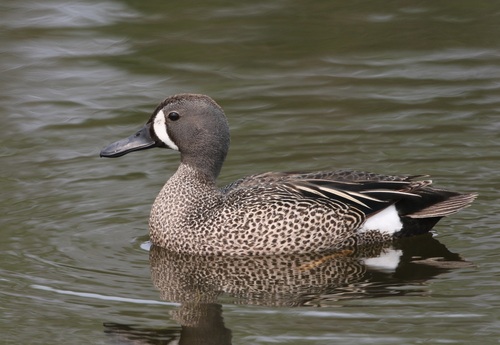
Blue-winged Teal
The Blue-winged Teal (*Spatula discors*) is a small dabbling duck found throughout North and South America. It is known for its distinctive bright blue shoulder patch, visible during flight, which contrasts with its overall brown and buff plumage. This species plays a significant role in wetland ecosystems as both a consumer of invertebrates and seeds and as prey for larger predators. It is also a popular game bird, carefully managed in many regions to ensure sustainable populations. The Blue-winged Teal is not considered to hold particular cultural significance beyond its general role as a symbol of wild wetlands.
36-41 cm
Length
58-63 cm
Wingspan
Least Concern
Conservation Status
Distribution
Breeds primarily in North America, from Alaska and Canada down to the northern United States. Winters from the southern United States through Central America and the Caribbean, extending into South America as far south as Peru and northern Argentina. Migratory routes are extensive, covering thousands of kilometers.
Lifespan
Average lifespan in the wild is not well documented but is estimated to be around 2-5 years, with some individuals living longer. Captive birds can live longer.
Blue-winged Teal's Habitat
Habitat Types
Shallow freshwater wetlands, Marshes, Ponds, Prairie potholes, Shallow lakes with emergent vegetation, Coastal estuaries (during migration and winter)
Climate Zones
Temperate, Subtropical, Tropical
Adaptations
Prefers shallow water bodies with abundant submerged and emergent vegetation, which provide both food and cover. Their relatively small size allows them to utilize smaller, shallower wetlands than many other duck species.
Variations
No widely recognized subspecies, though some minor plumage variations may occur between northern and southern populations.
Appearance
Breeding Plumage
Breeding males have a distinctive white crescent on their face, a grayish-blue head, and a black-spotted buff body. Females and non-breeding males are mottled brown. Both sexes have the bright blue shoulder patch.
Seasonal Feather Changes
Males molt into a duller 'eclipse' plumage after breeding, resembling females. They regain their bright breeding plumage in the fall.
Sex Based Plumage Differences
Significant sexual dimorphism in breeding plumage, with males being much more colorful.
Notable Features
Bright blue patch on the forewing (speculum), White facial crescent (breeding males), Relatively small bill
Diet and Feeding
Primary Foods
Aquatic invertebrates (insects, crustaceans, mollusks), Seeds of aquatic plants, Vegetation (leaves, stems), Small grains
Foraging Behavior
Dabbles in shallow water, tipping headfirst to reach submerged food. Also grazes on vegetation near the water's edge. Often feeds in small groups.
Specializations
Bill is adapted for straining small food items from the water and mud. The spatulate shape helps to sift through sediment.
Seasonal Diet Variations
Diet shifts with food availability. Invertebrates are more important during breeding season (for protein), while seeds and vegetation dominate in winter.
Behavior
Social Structure
Forms large flocks during migration and winter. During breeding season, pairs are more dispersed and territorial.
Communication
Soft quacks (female), Peeping whistles (male), Wing-flapping displays (during courtship and territorial defense)
Migration
Long-distance migrant. Travels in flocks, often at night. One of the earliest ducks to migrate south in the fall and one of the latest to return north in the spring.
Territorial or Group Behaviors
Males defend small territories around the nesting site during breeding season. Outside of breeding, they are highly gregarious.
Conservation
Threats
Habitat loss and degradation (wetland drainage and conversion to agriculture), Pollution (pesticides and other contaminants in wetlands), Climate change (altering wetland habitats and migration patterns), Hunting pressure (in some areas)
Protection Programs
North American Waterfowl Management Plan (international agreement), Wetland conservation programs (e.g., Ducks Unlimited, government agencies), Hunting regulations (to ensure sustainable harvests)
Local National Laws
Protected under the Migratory Bird Treaty Act in the United States and similar legislation in Canada and Mexico.
Population Trend
Stable
Population Estimates
Global population estimated to be around 6.8 million.
Interesting Facts
They are among the fastest-flying dabbling ducks.
Their speed and agility help them evade predators and undertake long migrations.
Blue-winged Teal are known for their long migrations.
Some individuals travel from Alaska to South America, a journey of thousands of miles.
The blue wing patch is iridescent.
The color is produced by the structure of the feathers, not pigment.
Faqs about Blue-winged Teal
What is the difference between a Blue-winged Teal and a Green-winged Teal?
Blue-winged Teal males have a white crescent on their face and a blue shoulder patch, while Green-winged Teal males have a green patch on their head and a green speculum (wing patch). Females are more difficult to distinguish but Blue-winged teal are larger and have a lighter head.
Do Blue-winged Teal mate for life?
No, they form seasonal pair bonds, meaning they typically choose a new mate each breeding season.
Where can I see Blue-winged Teal?
Look for them in shallow wetlands, marshes, and ponds during their breeding season (spring and summer) in North America. During migration and winter, they can be found in a wider range of wetland habitats, extending into Central and South America.
Copyright @ Nature Style Limited. All Rights Reserved.
 English
English